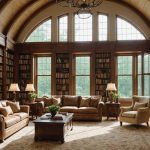Maximizing Natural Light in Home Libraries
Creating an inviting home library design entails thoughtfully considering the role of natural light. Not only does sunlight improve the aesthetics of a space, but it also significantly boosts mood and concentration, making it a vital component of the library ambiance.
Ideal Window Locations
To harness the full potential of daylight, positioning windows strategically is crucial. Placing them on the south or southeast side of the room ensures maximum sunlight throughout the day. Additionally, incorporating clerestory windows or skylights can introduce more light without sacrificing wall space, vital for shelving.
Also read : Sustainable bathroom makeover: the essential blueprint for water and energy efficiency
Reflection and Enhancement Techniques
Reflecting and amplifying natural light can transform a room into a vibrant reading nook. Mirrors placed opposite or adjacent to windows are excellent tools for spreading daylight farther into the room. Consider using surfaces like glass tables or light-coloured decor that further disperses light.
These design strategies not only utilise natural light to its fullest but also create a serene and bright home library. Leveraging this environment can significantly enhance one’s reading experience, fostering an atmosphere that encourages both relaxation and productivity.
In parallel : Transform your home with a warm and safe fireplace retreat: essential design insights for families
Designing Layout for Functionality and Aesthetics
Creating an effective home library layout design requires a delicate balance between functionality and aesthetics. Begin by assessing your space to determine how to create distinct zones for reading, studying, and organising materials. Fully utilising available space not only maximises utility but also enhances the library’s visual appeal.
When arranging furniture, consider the flow of natural light. Light is a powerful element in interior design, influencing both mood and productivity. Position chairs and desks to benefit from ample daylight, but avoid placing them in direct sunlight, which can cause discomfort. Incorporating mirrors or light-reflecting surfaces can also maximise light distribution.
Shelving and storage solutions play a pivotal role in both function and style. Opt for modular shelving units that can be adjusted as your collection grows. Choose materials and colours that harmoniously complement natural light, using lighter finishes to create an airy feel in smaller spaces. Vertical storage can be a smart choice, drawing the eye upward and freeing up floor space.
By thoughtfully designing your home library’s layout, not only do you ensure it caters to your practical needs, but you also craft a visually inviting space that encourages hours of leisurely reading and productive work.
Selecting the Right Furnishings
When designing a home library, choosing the right furnishings is crucial to enhancing both style and functionality. To maximise brightness, select materials like polished wood or glass, and opt for light-coloured finishes such as white oak or pastel hues. These choices reflect light, creating a welcoming and airy space. Consider the impact of your furniture on the room’s atmosphere.
For smaller spaces, multi-functional furnishings are a game-changer. Look for pieces such as foldable desks or shelving units that double as seating. This allows you to maximise utility without cluttering the room. Multipurpose furniture is ideal for flexibility and often includes built-in storage, helping keep your library organized.
Comfortable seating is imperative to a home library’s inviting atmosphere. Imagine settling into a plush armchair with a good book—this should be an essential element in your design. Durable fabrics and ergonomic designs ensure long-lasting comfort, making your library a haven of relaxation. Prioritising comfort not only encourages prolonged reading sessions but also enhances overall furnishings enjoyment.
To summarise, the right furnishings can transform any space into a functional and inviting library, balancing aesthetics and practicality.
Incorporating Decorative Elements
Enhancing your home library with decorative elements that embrace natural light can create a serene and inviting atmosphere. Select art and decor that reflect and amplify this light; pieces with glass, mirrors, or metallic finishes work beautifully. For example, a large mirror placed strategically can make your space feel larger and brighter.
Plants are a wonderful addition, offering both aesthetics and air quality benefits. Opt for those that thrive in abundant light, such as succulents, spider plants, or the ever-popular fiddle-leaf fig. Not only do they add a touch of nature, but they also purify the air, making your reading nook a healthier, more enjoyable space.
Light-colored textiles can further enhance the brightness of your home library. Choose airy curtains in soft tones like cream or pale blue to allow sunlight to fill the room. The same goes for rugs—opt for those in light hues that can reflect rather than absorb light.
By carefully selecting these decorative elements, you can transform your home library into a vibrant, welcoming space that maximizes the benefits of natural light, making every reading session a pleasure.
Optimizing Lighting Solutions
Creating an inviting home library environment relies heavily on strategic lighting solutions. In fact, choosing the right artificial lighting to complement natural light can influence both aesthetics and functionality. Types of artificial lighting like table lamps, floor lamps, and pendant lights can serve different purposes, enhancing the ambience in a home library.
To truly optimize your reading space, consider the importance of layering light sources. For tasks such as reading, writing, or studying, task lighting—such as adjustable desk lamps—can provide focused illumination. Meanwhile, ambient lighting, like ceiling fixtures or wall sconces, establishes a warm general glow. Layering light sources ensures that your lighting solutions cater to various activities, providing flexibility and avoiding eye strain.
When selecting the perfect light fixtures, it’s essential to harmonize with the overall design theme of the room. Whether you prefer a modern, vintage, or minimalist style, choose fixtures that reflect this aesthetic. Moreover, consider the fixture’s material, colour, and form to blend seamlessly with the library’s decor, ensuring a cohesive and welcoming environment for all your literary explorations.
Maintaining an Organized and Inviting Space
Keeping your home library organized and inviting requires a bit of strategy. When it comes to organizing, start by decluttering. Assess your collection and identify books you no longer need; donate or sell them to keep your space tidy. This reduces clutter and helps create an enjoyable environment.
Create a personal system for book organization that suits your needs and preferences. Whether alphabetically, by author genre, or even by colour, it’s important to choose a system that encourages use and makes locating a particular book easy. This not only enhances the library’s aesthetic appeal but also maximizes its practicality.
Regular updates play a crucial role in maintaining an inviting library. Keep the space fresh and inspiring by periodically rearranging the books, adding new titles, or tweaking the decor. This can make your library an appealing haven that inspires frequent visits and enhances your reading habit.
Besides just books, consider how other elements, such as comfortable seating, proper lighting, and a few personal touches, contribute to the overall atmosphere. A well-organized library does not only look good; it encourages an environment where reading feels like a leisure escape, fostering a lifelong love for books.











